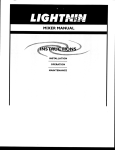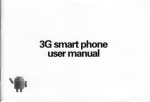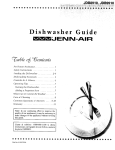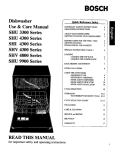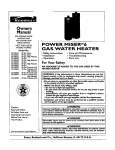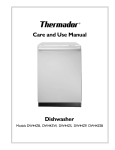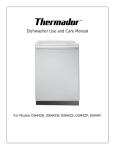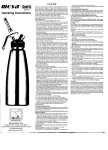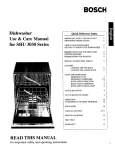Download Bosch SHU 3000 Operating instructions
Transcript
@
Dishwasher
Lave-vaisselle
Lavadora de platos
SHU 3000
BOSCH
Use and care manual
Read this manual
for important
instructions
-
safety and operating
Guide d'utilisation et
d'entretien
Lire ce guide
II contient d'importantes
instructions
de s6curit6 et de fonctionnement
Manual de uso y cuidado
Lea este manual
Para instrucciones importantes de
seguridad y operaci6n.
@
BOSCH
Quick Reference Index
Dishwasher
Use & Care Manual
for SHU 3000 Series
IMPORTANT SAFETY INSTRUC'rIONS
GROUNDING INSTRUCTIONS
2
2
ABOUT YOUR DISHWASHER
GETrING TO KNOW YOUR DISHWASHER
3
3
BEFORE USING FOR THE FIRST TIME
GETTING STARTED
........
PREPARATIONS FOR WASHING
4
4
4
SPECIAL INSTRUCTION, TABLE 1
5
LOADING
LOADING THE TOP RACK
LOADING THE LOWER RACK
6
6-7
RACK HEIGHT ADJUSTMENT
EXTRA TALL ITEMS
7
7-8
USING THE DISPENSERS
DETERGENT USE '
DETERGENT DISPENSER
RINSE AGENT INDICATOR
RINSE AGENT DISPENSER
RINSE AGENT REGULATOR
8
8-9
9
9
9
CYCLE SELECTION
CYCLE SELECTION CHART
lO
OPERATION
TO INTERRUPT OR RESET PROGRAM
11
11
UNLOADING
11
CARE & CLEANING
11-12
SERVICE and REPAIR
13
SELF-HELP
14
WARRANTY
15
READ THIS MANUAL
' _f-or important safety and operating instructions
IMPORTANT
SAFETY INSTRUCTIONS
WARNING -- When using your dishwasher, basic safety precautions should always be followed to
reduce the risk of fire, electric shock, and/or injury to persons, including the following:
1.
2.
3.
4.
5.
6.
7.
8.
9.
10.
11.
12.
Bosch dishwashers are provided with two manuals; one, Installation Instruction Manual and
one, Care and Use Manual. Read all instructions before using the dishwasher.
Use the dishwasher only for its intended function.
Use only detergents or wetting agents recommended for use in a dishwasher and keep them out
of the reach of ehildrea.
When loading items to be washed:
a. Locate sharp items so that they are not likely to damage the door seal,
and
b. Load sharp knives with the handle up to reduce the risk of cnt-type injuries.
Do not wash plastic items unless marked "dishwasher safe" or the equivalent. For plastic items
not so marked, cheek the manufacturer's recommendations.
Do not touch the heating element during or immediately after use.
Do not operate your dishwasher unless all the enclosure panels are properly in place.
Do not tamper with conla'ols.
Do not abuse, sit on, or stand on the door or dish rack of the dishwasher.
To reduce the risk of injury, do not allow children to play in or on the dishwasher.
Under certain conditions, hydrogen gas may be produced in a hot water system that has not
been used for two weeks or more. Hydrogen gas is explosive. If the hot water system has not
been used for such a period, before using the dishwasher turn on all hot water faucets and let
the water flow from each for several minutes. This will release any aceumnlated hydrogen gas.
As the gas is flammable, do not smoke or use an open flame during this time.
Remove the door to the washing compartment when removing an old dishwasher from service
or discarding.
WARNING -- This dishwasher must be grounded in.accordance with the National Electa'ical Code
and/or local cedes. These must be carefully followed in all cases. See Installation Instructions
provided with this dishwasher for complete installation information. Make sure this dishwasher has
been properly grounded and installed by a qualified installer before using.
SAVE THESE INSTRUCTIONS
GROUNDING
INSTRUCTIONS
This appliance must be connected to a grounded metal, permanent wiring system; or an equipment
grounding conductor must be run with the circuit conductors and connected to the equipment
grounding terminal or lead on the dishwasher.
2
HOUSEHOLD
USE ONLY
ABOUT YOUR DISHWASHER
Congratulations on having selected a BOSCH
dishwasher, the choice of those that demand quiet and
exceptional cleaning performance from their dishwasher.
The Bosch SHU 3000 series dishwashers offer the
•
•
following standard features:
•
Stainless steel inner liner and inner door
•
Exceptionally low water consumption
•
Four spraying levels
•
Height adjustable upper rack
(SHU 3012 UC and SHU 3016 UC only)
Figure 1, below, is an illustration of the dishwasher with its
features called out. For an explanation of the feature turn
to the page indicated.
Door Gasket
(page 12)
_
Upper Spray Arm
(pages4, 11, 12)
Upper Rack.
(pages 6,7)
Lower Spray Arm
(pages 4, 11, 12)
Lower Rack.
(pages 6. 7, 8)
(page 11)
Silverware Basket
(page7)
Rinse Agent Dispenser
(pageo)
Detergent Dispenser
(pages s,9)
Name/Rating
(at top or side of door, as ind'_ated)
_cel.
How-Through Heater TM for temperature boosting
Triple filter system
GETTING TO KNOW YOUR DISHWASHER
BEFORE USING FOR THE FIRST TIME
Before beginning to use your dishwasher for the first
time:
1. Check to make sure that the voltage on which the
dishwasher is to operate is the same as shown on
the rating plate.
2. Check to make sure that the water valve to the
dishwasher is open. The installer may have closed
the valve upon completing the installation.
3. Thoroughly inspect unit for cosmetic damage.
Cosmetic damage must be reported within 5 days.
I
I=
I
SHU 3000 series
control panel
Handle
OniO_
Button
Figure 2.
GETTING STARTED
The operation of your Bosch dishwasher is summarized
below:
1. Load the dishwasher.
Refer to Table 1 for items suitable for washing in the
dishwasher. The dishwasher should be loaded with
pots, pans, dishes and silverware according to the
instructions provided under the following section
titled LOADING.
2.
.
4.
5.
6.
Add detergent and check rinse agent.
Detergent must be placed in the detergent dispenser
compartment as described in the following section
titled DETERGENT USE. The use of a rinse agent is
required to ensure good cleaning and drying result.
See section titled RINSE AGENT DISPENSER.
Check motion of wash arms.
The wash arms must be free to move and should not
be blocked by any item extending so far above lower
rack as to block upper arm or by any items hanging
below either the upper or lower rack to obstruct the
motion of the wash arms. See following section titled
OPERATION.
Close the door of the dishwasher.
Make sure that the door is completely closed and
latched.
Select a w_h cycle, see Table 2, and depress the
corresponding cycle button, see Figure 2
Start the dishwasher.
Turn "Start and Run Knob" to "START" and depress
the On/Off button. The indicator light above On/Off
button will become illuminated and the the dishwasher
will start. The "Start and Run Knob" will rotate
clockwise as the dishwasher cycle progresses. By
noting where the knob is pointing to it is possible to
discern where in the cycle the dishwasher is at any
time.
7,
To stop dishwasher.
Depress the On/Off button. The indicator light above
the On/Off button will turn off. See the following
section titled TO INTERRUPT OR RESET CYCLE.
PREPARATIONS FOR WASHING
Very little preparation is required before placing dishes,
pots, pans, etc. into the dishwasher. However, some
preparation is required:
•
Large solids, such as, bones, large seeds, shells, skins,
leafy vegetables, meat trimmings, etc. should be
removed either by scraping into a wastebasket, or into
your food disposer.
•
Large amounts of any type of leftover food should
also be scraped into a wastebasket or into your food
disposer.
•
Pots and pans that have burned-on food, the food is
blackened, should be pre-soaked and scoured. The
dishwasher cannot remove burned-on food.
•
Do not place the following items in the dishwasher:
> toothpicks
> small bones and bone slivers
> paper products such as paper plates and paper
napkins
> plastic bags or plastic packaging material.
In general, try to remove food scraps and place the items
to be washed in the dishwasher before the food has had a
chance to dry-on. Dried-on food is more difficult to
remove. If there will be an extended period of time before
the dishwasher will be run it is recommended that the
RINSE & HOLD cycle be used.
Other than the above, no special preparation or pre-rinsing
is required for dishes, pots and pans or utensils with
normal amounts of food soil.
MATERIAL
DISHWASHER
USE
COMMENTS AND/OR SPECIAL INSTRUCTIONS
ADHESIVE
JOINED ITEMS
NOT
RECOMMENDED
Items joined by adhesives, whether plastic, wood, bone, siP.el,copper or
tin, etc. may be loosened.
ALUMINUM
USUALLY SAFE
Colored anodized aluminum may fade over time. Minerals in the water may
cause spotting or darkening of aluminum. This can usually be removed by
scouring with a soap filled steel wool pad.
BONE
HANDLED
UTENSILS
NOT
RECOMMENDED
Handles may separate.
CHINA &
STONEWARE
USUALLY SAFE
It is highly recommended however that "on-glaze" decorated china,
handpaiuted and gold or platinum trimmed, or antique china or stoneware
be hand washed. If there is any doubt, please check with the manufacturer
of your set or test by washing one piece with each load for a month and
comparing this piece with the rest of the set to determine if there has been
any fading or discoloration.
CRYSTAL
USUALLY SAFE
Decorated crystal, those handpainted, "on-glaze", or metal trimmed, may
discolor, fade, or spot. It is recommended that these be hand washed. Also,
fragile glassware is highly breakable, be sum to set the pieces so that they
do not topple during washing and so that they do not knock against other
pieces.
GLASS
USUALLY SAFE
Milk glass may yellow.
NON-STICK
COATINGS
USUALLY SAFE
After drying the non-stick coating should be covered with a light coating of
vegetable oil.
IRON
NOT
RECOMMENDED
Iron will rust. Wash by hand and dry immediately.
PEWTER
NOT
RECOMMENDED
Pewter will tarnish. Wash by hand and dry immediately.
PLASTIC
USUALLY SAFE
Only wash "dishwasher safe" plastic items.
STAINLESS
STEEL
USUALLY SAFE
Do not let stainless steel items contact copper or sterling silver or
silverplate items.
STERLING
SILVER &
SILVERPLATE
USUALLY SAFE
Do not allow to come in contact with stainless steel or copper items.
TIN
NOT
RECOMMENDED
Tin will rust. Wash by hand and dry immediately.
NOT
RECOMMENDED
Wooden bowls, wooden utensils and wood handled utensils can warp, crack
or lose their finish.
NOT
RECOMMENDED
The Bosch dishwasher is only intended for use in cleaning standard
household dishware items.
WOOD
NONDISHWARE
ITEMS
Table 1.
-
LOADING
China, crystal and other delicate items must be placed
so that they do not touch each other during dishwasher
operation. Chipping or other damage may occur if
items can touch each other while dishwasber is
running.
LOADING THE TOP RACK
The top rack is designed for glasses, cups, plates, bowls
and saucers. Glasses, cups, plates, bowls, saucers and
small pots may be loaded in many different positions to
fit your needs. Figure 3, shows a typical mixed load for
an upper rack washing load.
Large serving spoons and forks, spatulas, tongs and
large knives can be placed in top rack. Be sure to
space these large utensils so that water may flow
freely over them and so that water does not collect in
them; - - - serving spoons and ladles should be placed
facing downward so as not to collect water.
The dishwasher should be loaded so that water can
ci_ulate freely and reach every part of every item that is
tO be eleanad:
•
Cups, glasses and containers should be placed in upper
rack upside down so that water drains off of them and
does not collect in them. Tall narrow vessels, such as a
vase or tall glass, should be placed in the lower rack,
near the middle, for the best cleaning result.
At completion of loading of the upper rack check to
make sure that nothing is protruding through or
hanging beneath the bottom of the rack, which could
block the rotation of the spray arm.
Hgn_3.
The Bosch dishwashers have a special feature
incorporated into the flip down cup shelves on the side
of the upper rack. The ends of these shelves are
specially formed to help maintain spacing between
stemmed glasses. When in the flipped down position
long stemmed glasses may be placed in the second
row from the edge and placed so their stems rest in the
"V" formed ends of the shelves. When the cup shelves
are in the up position long stemmed glasses may be
placed in the first row with their stems placed to rest
between the tooth like projections of the shelves.
Figure 4.
LOADING THE LOWER RACK
•
Large and/or heavily soiled items should be placed in
the lower rack of the dishwasher. Heavily soiled pots
and pans should be placed face down. See figure 4.
The DLX series dishwashers (SHU 3012 UC and SHU
3016 UC) come with a lower rack that has two sets of
flipped down tines. With these models, ff more space
is needed for pots and pans, the rear two sets of tines
can be folded to the down position. Figure 5 shows the
lower basket with the rear sets of tines in the down
position to accomodate large pots.
Figure 6.
_reS.
Silverware should be mixed when placed in the
silverware basket. The purpose of mixing the
silverware is to avoid having them nest together, for
example if spoons would be placed together they
could nest together so that water could not properly
circulate across them to clean the surfaces.
Extra Tall Items
If you have extra tall items that cannot fit in the lower rack
without interfering with the upper spray arm or without
hitting the upper rack, the upper rack may be removed. A
special "Extra Tall Item Sprinkler" is provided with the
dishwasher to allow use of the dishwasher with upper rack
removed. See figure 7.
Silverware should be placed in the silverware basket
with the handles down, with the exception of the
knives, which in order to avoid accidentally cutting
oneself, should be placed with the handles up.
If you do inadvertently load the silverware basket with
the knife blades up it is recommended, to avoid cutting
yourself when unloading, that you remove the silverware
basket from the dishwasher and tip the contents out onto
a cutting board.
RACK HEIGHT ADJUSTMENT
The upper rack height of the The DLX series dishwashers
(SHU 3012 UC and SHU 3016 UC) is adjustable. There
are two positions, see figure 6:
- 1. The upper position is used to provide more room for
items to be placed in the lower rack.
2. The lower position is used to provide more room for
items to be placed in the upper rack.
To reposition rack:
a. First empty upper rack and pull rack partially out to
point where rack can be lifted upward as shown in
upper illustration of Figure 6.
b. Pull the rack forward and then up until rollers are
completely free of channels.
,c.
Reinsen the rack with the other set of milers on the
channel.
_re7.
To allow washing of exUa tall items:
1. With upper rack empty, remove it from the dishwasher
by pulling the rack partially out to the point where
rack can be lifted upward and out to disengage the
wheels from side rails.
7
I
Figure 9.
DETERGENT DISPENSER
The detergent dispenser on the Bosch dishwasher is
located on the inside of the door, see figure 1 as well as
figure 9 and 10. The detergent dispenser cover may be
opened by pulling the release tab (figure 10) toward you.
Figure 8.
.
Place the "Extra Tall Item Sprinkler" over the upper
rack spray outlet at the back of the dishwasher tub
(refer to figure 7) and turn clockwise to lock sprinkler
head in place.
Extra tall items may now be placed in lower rack for
washing, as shown in figure 8. To remove "Extra Tall Item
Sprinkler", to again allow use of upper rack, reverse
actions used to insert it.
Once the cover is open you will see two level marks:
"25" and "15". These refer to the volume when filled level
in milliliters. 15 milliliters is equivalent to 3 teaspoons. If
the detergent dispenser is completely filled it can hold
45 milliliters, or roughly 9 teaspoons.
USING THE DISPENSERS
For the best washing result it is important to use the correct
amount of detergent and rinse agent.
DETERGENT
USE
Use only fresh dishwashing detergent (,powder is
recommended) manufaetored specifically for dishwasher
use. Use of other types of detergents will result in
excessive suds. Be sure to check the phosphate content of
the detergent to be used. Phosphate helps prevent the
minerals in hard water from forming a film or spots on
dishes. Hard water requires your detergent to work harder.
In hard water areas you will find that detergents with high
phosphate levels will provide a better result. If the
phosphate level is low, below 8.7%, you may have to use
extra detergent in hard water areas.
Be sure to follow the dishwasher detergent manufacturer's
instructions when using the detergents. Concentrated
"-:detergents usually call for lower usage than do standard
detergents.
Note:
Do not use detergent when the RINSE & HOLD
cycle has been selected.
Release
_10.
The amount of detergent to be used depends on the cycle
selected and the water hardness:
•
For water of medium hardness and REGULAR WASH
cycle it is recommended that the detergent dispenser
be filled to the 25 milliliters, (5 tsp.) level.
•
Wxth hard water, or with the POWER SCRUB cycle,
it is recommended that the detergent dispenser be
completely filled, roughly 9 teaspoons.
•
With soft water the amount of detergent may be
reduced.
If you have water of medium or higher hardness and the
dishes do not come clean the cause, in the majority of
cases, is the use of too little detergent rather than too
much. If yon have very soft water, or chemically treated
soft water special care should be taken to use the minimum
amount of detergent. For these situations a high quality,
low phosphate detergent is recommended. Too much
detergent combined with soft water may cause etching of
glasswage.
After filling the detergent compartment close the cover
by sliding it over the detergent chamber and pressing
down on the button until it dicks shut. The detergent will
be dispensed automatically during the wash portion of the
cycle.
If the cover of the detergent dispenser is closing fully but
it won't latch this is most likely due to the dishwasher
having been stopped in mid cycle. Check the position of
the "Start and Run Knob", see Figure 2, to see if cycle has
been completed. If the cycle is not completed please refer
to section of this manual tiffed TO INTERRUPT OR
RESET CYCLE to reset cycle.
H_12.
RINSE AGENT INDICATOR
There is level indicator on the dispenser, see Figure 11
and 13. This indicator shows the level of rinse agent that is
in the rinse agent reservoir. As received, and when empty,
the level indicator on the dispenser will appear blank.
When the rinse agent reservoir is full the level indicator on
the dispenser will appear dark.
RINSE AGENT DISPENSER REGULATOR
The rinse agent reservoir of the Bosch dishwasher is
provided with a regulator calibrated from 1 to 6. See
Figure 13. This regulator controls the amount of rinse
agent dispensed. The dishwasher leaves the factory
preset to 3½. This has been chosen as the average setting,
however:
•
•
if you see streaks, it is recommended that the regulator
be turned to a lower number.
if water spots appear, it is recommended that the
regulator be turned to a higher number.
indicator
Rinse agent level indicator
Figure 11.
IMPORTANT
Rinse agent, or a rinse aid, is used to diminish water
spotting and to provide optimum drying results. Rinse
agent must be used at all times with the Bosch
dishwasher.
Dosage control
Figure 13.
RINSE AGENT DISPENSER
The rinse agent dispenser is locaw.d next to the detergent
dispenser. See figure 12. Rinse agent is available in liquid
or solid forrn..Do not use the solid type of rinse agent in
the Bosch dishwasher.
To
•
•
•
fill the rinse agent reservoir (refer to Figure 12):
Open the dishwasher door fully.
Open the cover of the rinse agent dispenser.
Add rinse agent to the reservoir until the clear level
indicator turns completely dark. The reservoir is full
when the level indicator is dark.
•
Close the cover of the rinse agent dispenser. Make
sure that it is firmly snapped closed.
TO ADJUST SETTING:
•
•
•
Open the cover of the rinse agent dispenser.
Turn the setting indicator to the desired setting. See
Figure 13.
Close the cover of the rinse agent dispenser. Make
sure that it is firmly snapped closed.
CYCLE SELECTION
The dishwasher will wash and dry the contents based on
cycle selection made. Refer to the CYCLE SELECTION
CHART, Table 2. The most appropriate cycle for the load
to be washed can be selected from this table by comparing
the load type and the amount and condition of the food on
the items to the charts recommendations.
9
Cycle Selection Chart
Type of dishware
e.g.chlna,
Delicate.
etc.glasses,cutlery,p°ts/pans'
[Non-dell- I
_
Type of food
remains
Soups, casseroles,
sauces, potatoes,
pasta, rice, eggs,
roast or fried food
Amount
of
I
food remains
a,ot
Condition
of I
food
remains
stuck on hard
Soups, potatoes,
pasta, rice, eggs,
roast or fried food
I [
a,o,
]
[a,i_,e]
Coffee, cakes, milk, I
salami, cold drinks,
salads
-
I a little
!
4,
Scrub
!
loosely attached ....
I
4,
wash
[Power]
cycle
I
Regular
Wash
Cycle
sequence
4,
Rinse
& Hold
Pre-rinse I
Cycle
details
in
75
73
6
Water consumption
in gallons _
6.1
5
1.1
23.1
18.9
4.2
Duration
minutes
Water consumption
in litres
Shown above are the range of values that may be obtained while running the dishwasher under normal
conditions. Actual values may vary. The actual cycle duration, water and energy usage are dependent upon
inlet water temperature.
tO
Table 2.
OPERATION
Once detergant has been added and before closing the door
of the dishwasher chock the wash arms to ensure that they
are free to move. With the detergent in the dishwasher and
arms free to move:
•
Close the door of the dishwasher making sure that
door latches closed.
•
Depress the button for the cycle you desire.
Turn the "Start and Run Knob" to "START" and
depress the On/Off button. See figure 2. The indicator
light above the On/Off button will become illuminated
to indicate that the dishwasher is on and the cycle will
begin.
Coarse/microfilter
Fine Filter
Figure 14.
TO INTERRUPT OR RESET CYCLE
To interrupt cycle simply depress the On/Off button to stop
operation. If you are interrupting the cycle during a wash
or rinse cycle please wait until the water noises stop before
opening the door. After opening the door leave it ajar for a
few minutes. The cycle then may be resumed by closing
the door and depressing the on/off button.
As a safety feature the dishwasher will automatically turn
itself off whenever the door is unlatched. However, if the
door is opened quickly while in a wash or rinse cycle some
water may splash out of the dishwasher. For this reason it
is recommended that the machine always be switched to
off before opening the door.
If you wish to reset the cycle to its beginning after
stopping the dishwasher:
1. Close the door of the dishwasher. Make sure that the
door is completely closed and latched.
2.
Turn the "Start and Run Knob" to "Start".
3.
The dishwasher is now reset and ready to ran your
selected wash cycle.
UNLOADING
When unloading the dishwasher always unload the lower
rack first and then unload the upper rack. This will
minimize the chance of drops from the upper rack falling
on the dishes in the lower rack. The silverware basket
of the Bosch dishwasher may be removed for easy
unloading. Also, when unloading, it is recommended that the dishes
be allowed to cool before handling. The dishes will cool
more quickly if the door is opened slightly.
CARE and CLEANING
The Bosch dishwashers have a triple filter system
comprised of: a microfilter, a fine filter and a coarse filter.
The microfilter is self-cleaning, but the coarse filter and
fine filter will sometimes be found to have collected items,
from bones to toothpicks or straws that been left on the
plates or in the glasses. For this reason the following
maintenance should be observed:
Filters
The filters should be checked on a regular basis. To
remove the filters, turn the knurled ring handle of the
coarse/microfilter ¼ turn counter-clockwise, see figure
14, and lift out the coarse/microfilter. After removing
the coarseYmicrofilter the fine filter should also be
inspected from time to time. Examine the filters. If
large solids, such as bones, or large seed(s) are present
remove the filters and dispose of the large solids by
emptying into a waste basket. If any other items have
been trapped by the filters, paper labels for example,
these should also be removed while yon have the filters out of the dishwasher. These smaller items can
usually be flushed out under running water if you have
trouble removing them by hand.
After cleaning, reinsert the filters in the dishwasher
making sure to press.the filters firmly into position,
and then turning the knurled ring ¼ turn clockwise
until locked. Pull gently on the knurled ring to make
sure the filters are again locked in place.
Other areas requiring periodic maintenance are the wash
arms and the stainless steel tank and inner door and door
gasket:
•
Wash arms
The wash arms should be chocked on a regular basis
to assure that the spray orifices are clear and
unobstructed. If the wash arms require cleaning they
are easily removable:
11
Figure 15.
> The lower wash arm simply snaps into place and
can be removed by pulling upwards.
> The upper wash arm is held in position by a locking
ring that can be released by turning it approximately
1/8 tam. See figure 15.
After cleaning, reattach the wash arms by reversing
the action used to remove them.
Stainless Steel Tank and Door
The outer edges of the inside door panel should be
cleaned on a regular basis to remove food particles
that can gather there from normal loading. If spots
begin to appear on the stainless steel door or tank
check to make sure that the RINSE AGENT
RESERVOIR has rinse agent in it. Also it is possible
that the wash arms are blocked, which prevented the
door as well as your dishware from being properly
washed and rinsed. Check the wash arms to make sure
they are moving freely. If not, clear the obstruction
away so that the arms may rotate freely and then
rewash the load of dishes in the dishwasher.
Spots that appear on the stainless steel door may be
removed by wiping gently with a sponge sprinkled
with a stainless steel cleaner. Do not us_ metal
scouring pads to clean the stainless steel surfaces
as these can scratch the surface and leave metal
fragments that can rust.
Door Gask*t
The door gasket should be cleaned on a regular basis
to remove food particles that can gather from normal
loading. If necessary
damp cloth.
12
clean the door gasket using a
SERVICE
and REPAIR
The Bosch dishwasher requires no special care other than
the care and cleaning noted above. If 3_ouare having a
problem with your dishwasher, before calling for service
please refer to Table 3, SELF-HELP section, following.
If service becomes necessary, contact your dealer or
installer or an authorized service center. Do not attempt
to repair the appliance yourself. Any work performed by
unauthorized personnel may void the warranty.
If you are having a problem with your BOSCH dishwasher
and are not pleased with the service you have received:
•
•
First, please contact your installer or the Bosch
Authorized Service Contractor in your area and
explain to them why you are not satisfied. This will
usually correct the problem.
If after working wi_ your installer or service person
the problem still has not been resolved to your
satisfaction, please let us know by either writing to us
at,
Please be sure to include, if writing, or have available, if
calling, the following information:
•
Model Number
•
Serial Number
•
Date of Original Purchase
*, Date Problem Originated
•
Explanation of Problem
Also, if writing, please be sure to include a daytime phone
number.
You will find the model number and serial number
information on the rating plate located on the door of the
dishwasher. See Figure 1.
Robert Bosch Corporation
Dept. HPS
2800 South 25th Avenue
Broadview, IL 60153
or,
calling us at,
1-800/944-2904.
(Staffed, 8:30 AM - 4:30 PM CST.)
13
SELF-HELP
Dishwashers may exhibit problems that are utirelated to a malfunction of the dishwasher itself. The following table may serve
to answer your question about a problem you are having without having to call a serviceman.
PROBLEM
POSSIBLE
Dishes do not dry
Rinse-aid dispenser is empty. Fill rinse-aid dispenser.
Indicator light(s) do
not come on
A fuse may have blown or a circuit breaker tripped. Replace fuse or reset circuit breaker at
your fuse box/breaker box.
Dishwasher does not
start
Door of dishwasher not properly closed. Close dishwasher making sure that door latches.
Dishwasher runs a
long time
If the dishwasher completes the cycle, but the run time seem exceptionally long it is probably
due to cold incoming water. To avoid this problem it is recommended that before starting the
dishwasher: open the hot water faucet at the sink nearest the dishwasher and run the water
until the water is hot. Then turn off the water and start the dishwasher.
Machine cycle does
not advance to rinse
Water line is closed or inlet filter is blocked. Open water valve and/or check inlet filter.
Water not pumped
from dishwasher
Kink in drain hose. Filter clogged. Kitchen sink clogged. Air gap (type installed at sink)
clogged. Check drain hose and fine and coarse filters (see section titled CARE and
CLEANING). Check kitchen sink to make sure it is draining well. If problem is kitchen sink
not draining you may need a plumber rather than a serviceman for the dishwasher.
Detergent dispenser
lid will not close
A program was not completely finished.
Lower spray arm does
not rotate freely
Remove lower spray ann and clean arm and spray arm mounts.
White deposits left on
dishes
Too little rinse-aid.
Streaks on glassware
Too much rinse-aid used.
Rattling noises
Utensils not properly arranged.
Suds in dishwasher
Incorrect type of detergent used. Use only automatic dishwasher detergents.
Unsatisfactory
washing result
•
•
•
•
•
•
TABLE 3.
14
CAUSE
Incorrect amount of detergent or rinse agent.
Utensils incorrectly arranged or rack overloaded.
Wash arm rotation blocked by utensils.
Filters not properly fitted into position.
Clogged nozzles in wash arm(s)
Unsuitable program selected.
STATEMENT OF WARRANTIES
BOSCH DISHWASHER
The warranties provided by the Robert Bosch Corporation ("Bosch") in this Statement of Warranties apply only to Bosch Dishwashers sold
to the first using purchaser by Bosch or its authorized dealers, retailers or service centers in the United States or Canada. The Warranties
provided herein are not transferable.
LENGTH OF WARRANTY
SCOPE OF WARRANTY
5 day Limited Warranty - Cosmetic Damage From Date of Installation*
Bosch will repair any Dishwasher that is delivered or installed
with any cosmetic damage free of charge, labor and shipping
costs included.
1 Year Full Limited Warranty
From Date of Installation*
Bosch will repair or replace any component part that proves
defective under conditions of normal home use free of charge,
labor and shipping costs included. Repair service must be
performed by an Authorized Bosch Service Center.
2 Year Limited Warranty
From Date of Installation*
Bosch will provide replacement parts free of charge for any
component part that proves defective under conditions of normal
home use. labor charges excluded.
5 Year Limited Warrantyon Electronics
From Date of Installation*
Bosch will repair or replace any microprocessor or printed
circuit boards that prove defective under normal use during the
second through fifth year from the date of original purchase,
labor charges excluded.
5 Year Limited Warranty
From Date of Installation*
Bosch will replace the upper or lower dish rack (excluding
rack components) free of charge, if the rack proves defective in
materials or workmanship under conditions of normal home use,
labor charges excluded.
Lifetime Limited Warranty against Stainless Steel Rust
Through
From Date of Installation*
Bosch will replace your dishwasher with the same model or a
current model that is equivalent or better in functionality if the
inner liner should rust through under conditions of normal home
use, labor charges excluded.
Bosch will replace the stainless steel door of any dishwasher if
the door should vast through under conditions of normal home
use, labor charges excluded.
* Date of installation
shall refer to the earlier
of the date the dishwasher
is installed
or ten business
days after the delivery
date.
Exclusions.
This warranty does not cover service calls or repairs to correct the installation of the dishwasher, to provide instructions on the use of your dishwasher, to
replace house fitses or coirect plumbing or the electric wiring in your home or to repair any dishwasher that's use was in a manner other than what is normal
and customalT for home use. In addition, the warranties provided in this Statement exclude any defects or damage arising from accident, alteration, misuse,
abuse, improper installation, unauthorized service work, external forces beyond Bosch's control, such as fire, flood, mad otbex acts of God, or installation not
.
in accordance with local electrical and plumbing codes. Labor charges incurred in the repair or replacement of any dishwasbex after the one year from date of
installation shall not be covered by this warranty. Any and all replaced and/or repaired parts shall assume the identity of the original for puq3oses of the
applicable warranty period.
TO THE EXTENT
PERMITTED
BY LAW, THIS WARRANTY IS IN LIEU OF ALL OTHER EXPRESS AND IMPLIED WARRANTIES,
INCLUDING
THE IMPLIED WARRANTIES OF MERCHANTABILITY AND FITNESS FOR A PARTICULAR PURPOSE. BOSCH DOES NOT ASSUME ANY
RESPONSIBILITY FOR INCIDENTAL
TO OBTAIN WARRANTY SERVIC_
OR WRITE BOSCH DIRECTLy
DISHWASHER'S
OR CONSEQUENTIAL DAMAGES.
CONTACT THE NEAREST BOSCH AUTHORIZED
SERVICE CENTER OR CALL 1 - 800 / 944 - 2904,
AT: UA/HPS, 2800 SOUTH 25TH AVENUE, BROADVIEW, ILLINOIS 60153. BE SURE TO PROVIDE YOUR
MODEL, SERIAL NUMBER, PURCHASE DATE AND THE SELLER'S
NAME AND ADDRESS. l
15
NOTES
56 O0 O0 30 93 (7710)


















